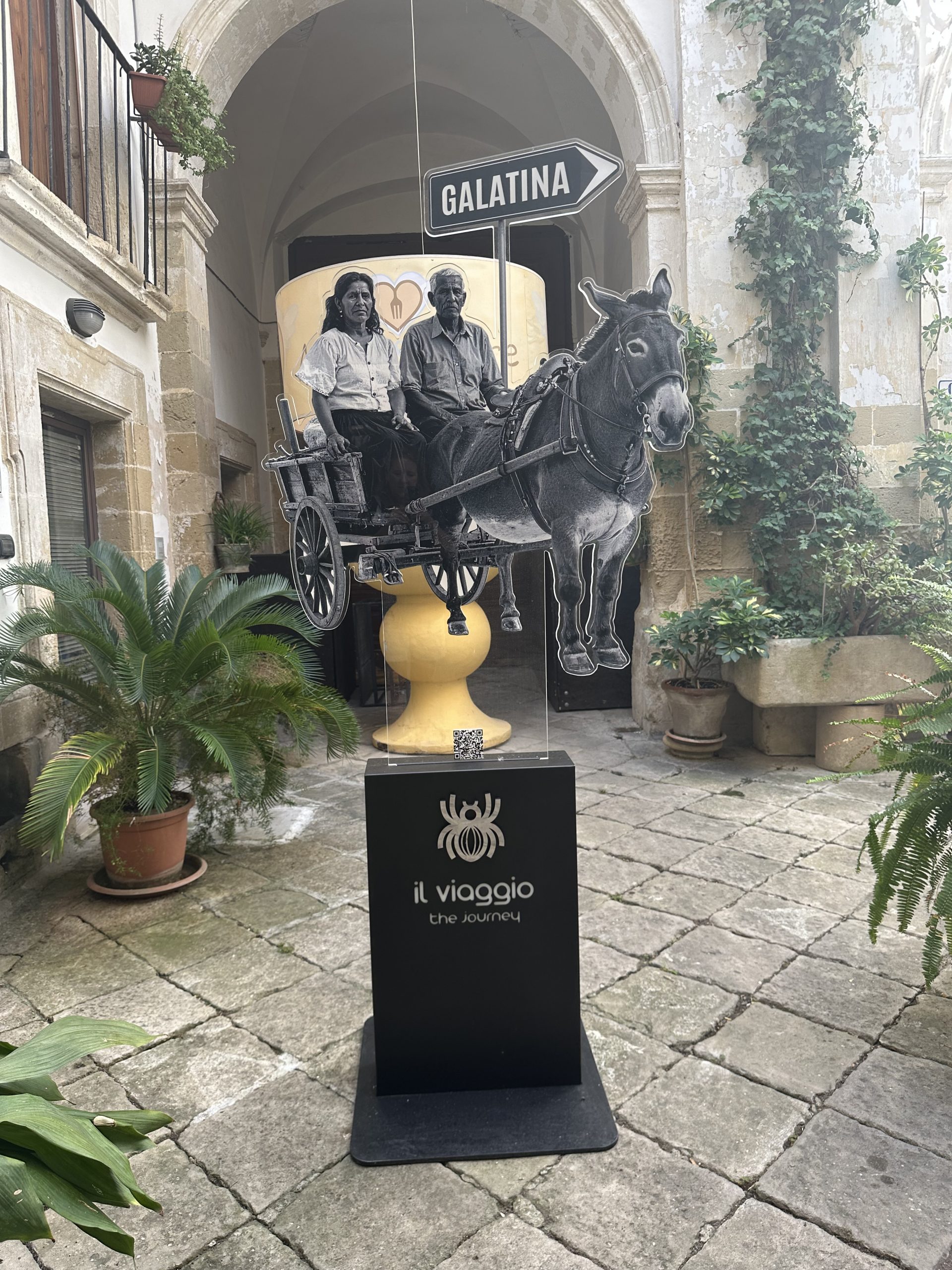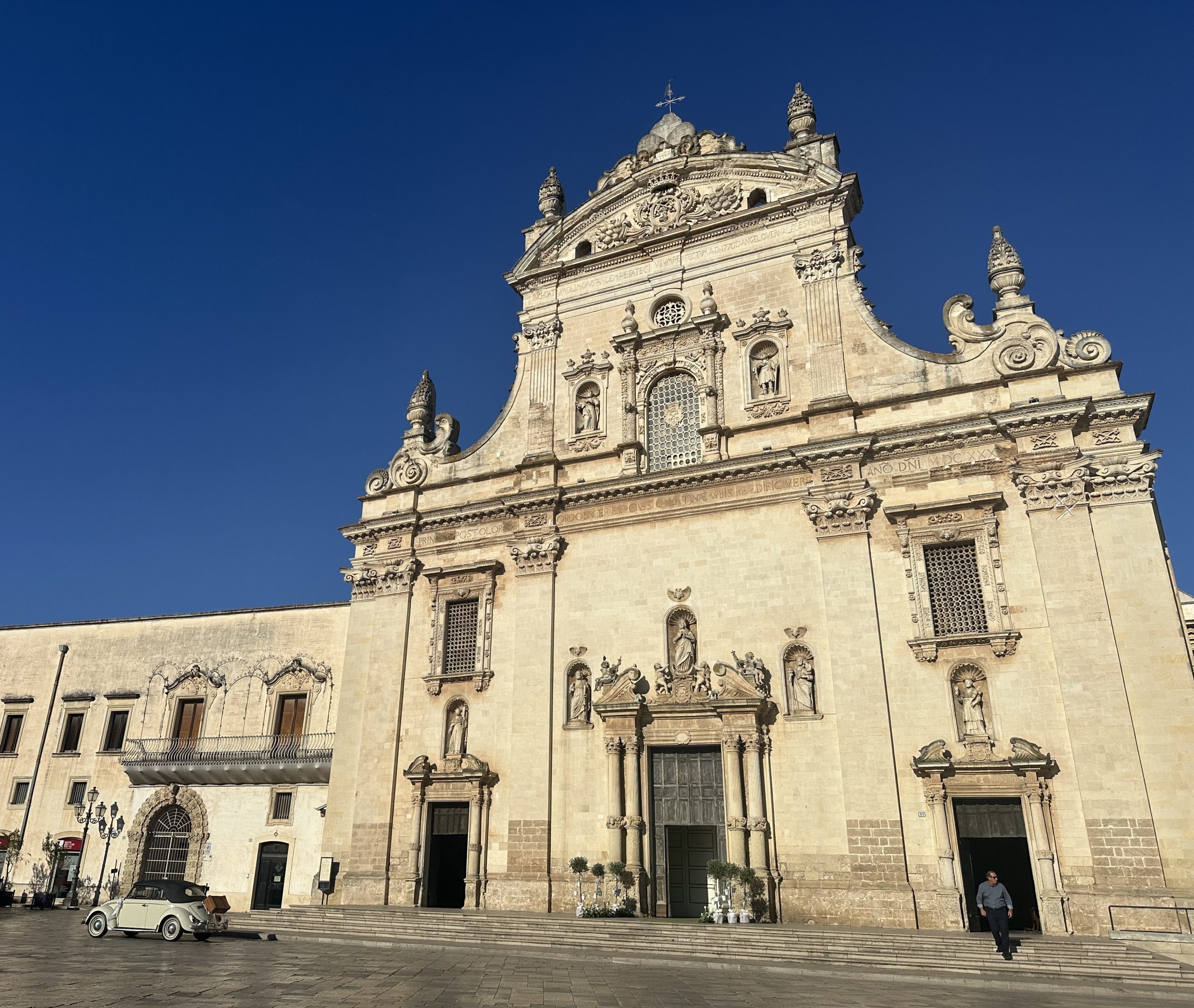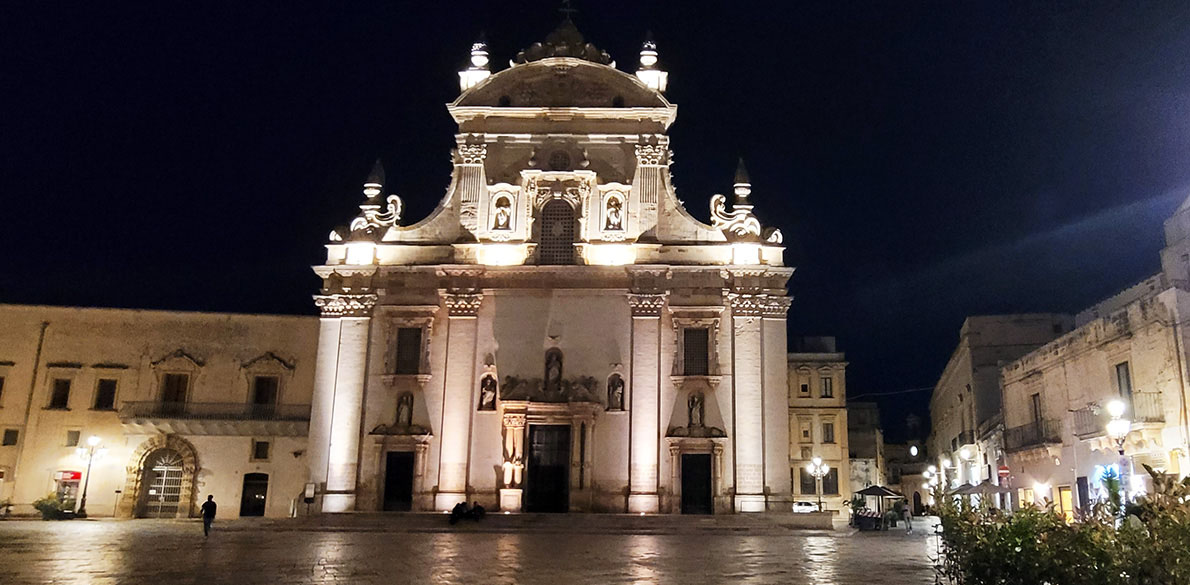A little history and 2026 Travel Guide
Historical and Cultural Attractions
Galatina is a town steeped in history, with many beautiful churches, palaces, and other historic buildings to explore. There has been an elegant town here since the 12th century. You will love the Puglia Romanesque style, with impressive doorways and balconies, decorated with intricate stonework. One of the town’s main attractions is the Basilica of Santa Caterina d’Alessandria, known for its stunning frescoes and Baroque architecture.

The Basilica of Galatina

The Church of Saint Peter and Saint Paul
Inside the Church of St. Peter and Paul

The founding year is unknown, but this church dominates the Piazza San Pietro and has ancient roots- linked to the apostles’ Saint Peter and Saint Paul’s visit to the area. The Baroque style church is dedicated to its patron saints.
This painting remembers how Saint Peter asked to be crucified upside down, as he did not feel worthy to die in the same manner of Jesus. This act demonstrated humility and may have also signified that the world’s values were upside down.
The history of the Tarantella or Tarantism in Galatina

History of Tarantella, St. Paul’s well and Chapel- Corso Garibaldi 7, Galatina
The Chapel and St. Paul’s well

This historic well and tiny Chapel are located in a Piazza via Garibaldi 7
St. Paul is known for battling a snake in Malta, and became known as the protector against poisonous animal bites and stings. The Apostle Saint Paul stopped in Galatina on his way to Rome. He was provided lodging by a noble family and as thanks, he gave them a well that happens to cure maladies inflicted by poisonous animals.
Tarantulas?
Galatina is historically linked to the cult of Tarantism, an illness caused by a spider bite. Are there Tarantulas in Southern Italy? NO The translation actually means spider (not Tarantula), and probably refers to the Wolf spider- While the name “Tarantula” is commonly used for the wolf spider Lycosa tarantula. It’s important to note that true tarantulas belong to a different spider family- and the Wolf Spider is venomous, but not considered particularly toxic to humans. The spider may have been blamed for a number of maladies that Southern Italian villagers could not understand centuries ago.
The Greek mythology of Arachne may also have fed this tradition. Peasant villager, Arachne, thought herself better than the deities, especially in the art of weaving wool. Athena challenged Arachne to a weaving contest. Athena’s tapestry depicted scenes of the Gods in their glory, but Arachne’s weaving illustrated the misdeeds and indiscretions of the gods, especially Zeus, and Athena. In a fit of rage, Athena destroyed Arachne’s tapestry and loom. In the end, Athena took “pity” on Arachne and transformed her into a spider, condemning her to weave forever.
The ‘Cure’
The tradition held that part of the cure for the spider maladies would be the dance of the frenetic Tarantella . The maladies were different though, and required the ailing woman to pull a colored ribbon. This ribbon would then instruct the musicians on the particular curative music to be played for the suffering victim.
This well and the tiny chapel (via Garibaldi 7) have been the center of Tarantism for centuries. Each year-victims from all over Southern Italy would come to Galatina and perform a ritual exorcism that involved drinking sulfur water from the well (which was vomited directly back into the well), a visit to the chapel and the performance of a spider-dance to the frenzied sounds of accordion, tambourine, violin and guitar.
In the 1960s the church condemned the rituals for the people of Galatina. Tarantism became taboo. The dance was getting to be an embarrassment to the church – occasionally obscene with women ripping their clothes off and climbing walls. The rituals highlighted an unenlightened peasant culture, and the ‘miraculous’ well was now contaminating more people than it cured. The chapel and Saint Paul’s well fell into disrepair and were closed off to the public.

The sites have recently been restored and reopened, and musicians and dancers of all ages still flock to Galatina on June 29 to play the traditional peasant songs, wave the colored ribbons, and scarves -and dance the Tarantella.
The Food
Galatina is known for its rich culinary heritage and its contribution to Italian cuisine.
The town’s cuisine is influenced by the region’s agricultural abundance and the traditions of its people, resulting in a unique and diverse array of dishes that are loved by locals and visitors alike. Farm to table/ Sea to Table – delicious food and wine
Galatina is famous for inventing the famous pastry called Pasticciotto (a custard filled pastry)

You may also enjoy “purceddhruzzi,” a type of fried dough made with flour, water, and yeast, and typically served at festivals and celebrations.
In addition to these sweet treats, Galatina is known for its savory dishes, such as “Ciceri e tria,” a traditional pasta dish made with chickpeas and handmade noodles. Another local specialty is “Peposo,” a hearty stew made with beef, red wine, and a variety of herbs and spices.
Galatina’s cuisine also features an abundance of fresh seafood, with dishes like “orecchiette alle cozze,” a pasta dish made with small shell-shaped pasta and mussels cooked in a flavorful tomato sauce.
The town is also known for its delicious olive oils, cheeses, and wines, which play a prominent role in many of its traditional dishes.
Overall, Galatina’s culinary delights offer a taste of the region’s rich history and vibrant culture, making it a must-visit destination for food enthusiasts looking to experience the best of Italian cuisine.
Learn about the irresistible wines of Puglia

Galatina Restaurants from Farm and Sea… to Table
 Il Fienele
Il Fienele
New location opening soon. A top-notch restaurant, opposite the Basilica di Santa Caterina run by talented chef Paolo Adamo, born and bred in Puglia. Great fresh Mediterranean and Pugliese cuisine. +39 392 037 8604 , Galatina. Il Fienele Menu
 Anima & Cuore
Anima & Cuore
Nice restaurant close to the Piazza San Pietro. This beautiful restaurant is on second floor, with big roof terrace for eating outside. Creative and delicious dishes- great service. Popular with Italian families, good seafood, good wines and high-end liquors. +39 0836 564301 (Corso Garibaldi 7, Galatina) Anima & Cuore Menu
 La Tana Del Lupo
La Tana Del Lupo
This tiny restaurant has about 5 inside/5 outside tables and there isn’t a menu. Instead, Francesco and his wife, Lole, just start bringing you food and wine the moment you sit down. Traditional, home-style food… Don’t be surprised if Francesco sings or plays the guitar for you.
+39 339 684 1750 (Via Del Balzo 26, Galatina).

Corte Del Fuoco
Outstanding restaurant. Delicious cuisine from Puglia, both the land and the sea, with local and regional products and wines . Excellent service in a charming indoor or elegant courtyard setting . Perfect for dining with friends, a quiet conversation, or long boozy lunch. Piazza San Lorenzo 5 Via Cavour (+39 0836 565858) Corte Del Fuoco Menu

La Conceria
This pizzeria and osteria is regarded as one of the best
restaurants in town. Situated in a large masseria on the edge of Galatina, it combines great food and entertainment with a pleasant tree-filled outdoor space. It’s possible to walk from the house (about 20 minutes), but there is plenty of parking available. +39 0836 210601 (Via Varese 57, Galatina)
 Roger 65 – A true Alchemist
Roger 65 – A true Alchemist
Start your evening with an aperitivo in the tiny bar Roger65 – or end up there for a nightcap. Carlo is a true master of mixology. Even more interesting -they make their own artisan syrups for cocktails- in flavors you have never tasted (like the Salento Olive Syrup). Highly recommended. Via Vittorio Emanuele II, 6, Galatina (+39 389 429 3710). Roger65 Menu
 Beautiful Central Location
Beautiful Central Location
Galatina is perfectly located in the heart of the Salento region, known for its stunning coastline and beautiful countryside. Visitors can explore the nearby beaches, olive groves, and vineyards, as well as the charming nearby towns and villages. You can easily reach 3 coasts within 30-40 minutes.
Festivals and Events
Galatina hosts several festivals and events throughout the year, celebrating everything from music and food to culture and traditions. The town’s famous “Notte della Taranta” is a popular music festival that attracts visitors from all over the world.
Overall, Galatina offers a perfect blend of history, culture, gastronomy, and natural beauty, making it a wonderful destination for travelers looking to experience the best of Italy.
How is the Tarantella Dance related to Galatina?
The Tarantella dance is a traditional Italian folk dance that is believed to have originated in the town of Taranto in southern Italy. It is often associated with the bite of the tarantula spider, as it was believed that dancing the Tarantella could cure the venom of the spider.
The town of Galatina, also in southern Italy, is known for its own version of the Tarantella dance called the “Pizzica.” The Pizzica is a frenzied and passionate dance that is said to have originated as a way for people to rid themselves of the venom of the tarantula spider. The “Notte della Taranta” (Night of the Tarantula) is a music and dance festival that takes place every summer in the town of Galatina, celebrating the traditional music and dance of the region, including the Tarantella. This festival draws thousands of people each year to participate in the lively festivities.
The Old Traditions

and the New Traditions

Local Festivals in Galatina: Celebrations
Galatina is known for its rich cultural heritage and vibrant local festivals that celebrate the town’s traditions and folklore. Here are some of the most popular festivals in Galatina:
1. Festa di San Pietro e Paolo: Held on June 29th, this festival celebrates the patron saints of Galatina, Saint Peter and Saint Paul. The day is marked with a religious procession, music and dance performances, and traditional food and drink.
2. Festa di San Giovanni Battista: Taking place on June 24th, this festival honors Saint John the Baptist with religious ceremonies, horse parades, and a lively street market.
3. Festa di San Sebastiano: Celebrated on January 20th, this festival pays homage to Saint Sebastian, the town’s protector against the plague. The day is marked with a procession through the town, traditional music and dance, and a fair with local food and crafts.
4. Festa della Taranta: One of the most famous festivals in Galatina, this event celebrates the traditional music and dance of the tarantella. Held in August, the festival features live performances by local musicians, dance workshops, and a parade through the streets of the town.
5. Sagra della Puccia: A culinary festival held in the Summer, the Sagra della Puccia highlights the traditional bread of Puglia, known as puccia. Visitors can sample a variety of puccia sandwiches filled with local ingredients and enjoy live music and entertainment.
Galatina’s local festivals offer a unique opportunity to experience the town’s cultural heritage and vibrant atmosphere. Whether you’re interested in religious traditions, music and dance, or culinary delights, there’s something for everyone to enjoy.

Other Festivals in Puglia
Historical Landmarks of Galatina: Must-Visit Sites
 1. Basilica of Santa Caterina d’Alessandria: This stunning church is one of the most important landmarks in Galatina, known for its beautiful frescoes and Baroque architecture. There is beauty and interest in every section. Plan to spend time there and ask for the bar code for the audio tour.
1. Basilica of Santa Caterina d’Alessandria: This stunning church is one of the most important landmarks in Galatina, known for its beautiful frescoes and Baroque architecture. There is beauty and interest in every section. Plan to spend time there and ask for the bar code for the audio tour.
The Basilica also houses the relics of Santa Caterina, and Santa Agatha (among others) making it a popular pilgrimage site. Learn more about how a Nobleman went to the holy land and bit off Caterina’s finger and brought it back to Galatina to start the Basilica

2. Church of San Pietro: This ancient church dates back to the 14th century and features a beautiful Gothic facade and stunning frescoes inside. It is a must-visit for history and art lovers.

3. Palazzo Mirelli: This historic palace was once the residence of the Mirelli family, one of the most influential families in Galatina. The palace is a beautiful example of Baroque architecture and is definitely worth a visit.
4. The Fountain of Santa Maria della Grazia: This fountain is located in Piazza Aldo Moro and is one of the most iconic landmarks in Galatina. The fountain is adorned with sculptures and is a popular meeting spot for locals and tourists alike.
5. Palazzo Orsini: This historic palace dates back to the 16th century and is known for its beautiful courtyard and frescoed ceilings. It is now home to the municipal library and is open to visitors for tours.
6. Church of San Paolo: This church dates back to the 16th century and features a stunning Baroque facade and beautiful frescoes inside. It is a must-visit for those interested in religious art and architecture.
7. Church of San Francesco: This historic church dates back to the 13th century and is known for its stunning Gothic architecture and beautiful frescoes. It is a peaceful place to visit and learn about the history of Galatina.
8. The Church of the Holy Souls of Purgatory. Have you ever been to a Purgatory Church? The exterior and interior of the church are decorated with skulls. The interior also features a painting of Souls trapped in Purgatory. The Purgatory Catholic Church was a place for you prayed for people in Limbo or Purgatory (not quite Heaven or Hell). The Church has moved away from emphasizing limbo, focusing instead on universal salvation.
9. Palazzo Marchesale: This historic palace was once the residence of the local nobility and is now a popular venue for cultural events and exhibitions. The beautiful example of Renaissance architecture is definitely worth a visit.
10. The well of St. Paul, and tiny chapel in via Garibaldi 7. St. Paul stopped in Galatina on his way to Rome. He stayed with a Noble family who generously gave food and lodging. In return he provided a blessed well to cure the maladies of poisonous animals and insects. The well became the center of tarantism for centuries- especially on St. Paul’s feast day on June 29th with a ritual exorcism, and the dance of the Tarantella





11. Take a Pasta making lesson in nearby Corigliano d’ Otranto

Galleries and Museums in Galatina
Galatina is home to several galleries and museums that are dedicated to preserving its rich cultural heritage.
These institutions showcase a diverse range of artifacts and artworks that tell the story of the town’s history, traditions, and artistic achievements.
One of the most prominent museums in Galatina is the Museo Civico, located in the historic Palazzo Tamborino-Cezzi. This museum houses a collection of archaeological finds, medieval artifacts, and religious objects that provide insight into the town’s past. Visitors can explore ancient pottery, Roman coins, and sculptures, as well as religious paintings and sculptures from the Renaissance period.
Another must-visit cultural institution in Galatina is the Museo Storico dei Pupi, a museum dedicated to Sicilian puppet theater. This unique museum showcases a collection of intricately crafted puppets, stage sets, and costumes that bring to life the characters and stories of traditional Sicilian puppet shows. Visitors can learn about the history of this art form and watch live puppet performances during special events and festivals.
In addition to these museums, Galatina is also home to several art galleries that feature works by local and international artists. The Galleria dell’Immagine, for example, showcases contemporary art in a variety of mediums, including painting, sculpture, and photography. The gallery hosts rotating exhibitions that highlight the talent and creativity of emerging and established artists.
Overall, the galleries and museums in Galatina play a crucial role in preserving the town’s cultural heritage and promoting artistic expression. Whether you are interested in archaeology, history, traditional crafts, or contemporary art, there is something for everyone to enjoy and learn from in Galatina’s cultural institutions.


